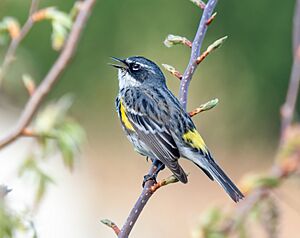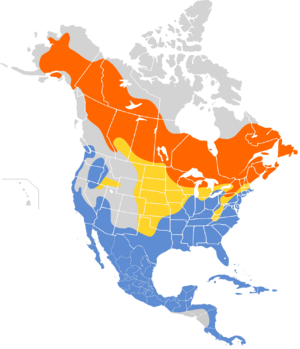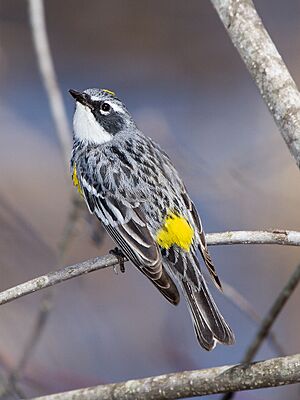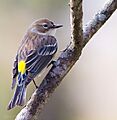Yellow-rumped warbler facts for kids
Quick facts for kids Yellow-rumped warbler |
|
|---|---|
 |
|
| Adult male myrtle yellow-rumped warbler singing | |
| Conservation status | |
| Scientific classification | |
| Genus: |
Setophaga
|
| Species: |
coronata
|
| Subspecies | |
|
|
 |
|
| Approximate distribution range of S. coronata coronata
Nonbreeding Breeding Migration |
|
| Synonyms | |
|
|
The yellow-rumped warbler (Setophaga coronata) is a common bird found all over North America. You can spot them from the Pacific to the Atlantic coasts of the U.S. and Canada. They also live in Central America.
These birds like to live in coniferous forests (forests with trees like pines and spruces) when they are raising their young. In winter, they fly south to warmer places. They prefer open areas with shrubs where they can find food. Yellow-rumped warblers mostly eat insects. But they also enjoy fruits like juniper berries, especially in the colder months.
There are four types of yellow-rumped warblers. These include the eastern myrtle warbler and the western Audubon's warbler. There's also the black-fronted warbler from northwest Mexico. And the Goldman's warbler from Guatemala. All of them have a bright yellow patch on their rump, which is why they are called "yellow-rumped."
Contents
What's in a Name?
The name Setophaga comes from old Greek words. Ses means "moth" and phagos means "eating." So, it means "moth-eating." The word coronata means "crowned." This refers to the yellow patch on their head.
How Scientists Group Them
Since 1973, many bird experts have decided to group these birds as one species. However, some experts still think they should be separate species. For example, the International IOC World Bird List sees the myrtle, Audubon's, and Goldman's as different species. Scientists are still discussing the best way to classify them.
Where Do They Live?
Yellow-rumped warblers breed across North America. Their breeding areas stretch from Alaska to the Pacific coast. They also go south into Western Mexico. The Goldman's warbler lives only in the highlands of Guatemala and does not migrate. The black-fronted warbler also stays in Mexico.
The myrtle and Audubon's warblers are migratory. This means they travel long distances. They fly to the southern U.S., Mexico, Central America, and the Caribbean for winter.
The myrtle warbler breeds from Alaska across Canada to Newfoundland. They also breed as far south as New England and Virginia in the U.S. In winter, they fly south. You can find them from southern British Columbia all the way to Panama. They are also common throughout the southeastern United States.
Audubon's warblers breed in western North America. They live in the Rocky Mountains, from British Columbia to California. They can be found as far east as the Dakotas. Audubon's warblers are very common in North America during winter. They are often the last warblers to leave in the fall. They are also among the first to return in spring.
Their Home Sweet Home
Summer Homes
During summer, when they are breeding, yellow-rumped warblers usually live in coniferous areas. They also live in mixed forests. These are places where conifers grow with trees like aspen and willow. Many of their homes in the western U.S. are in mountains. But they can also live near the sea if there are conifers. This happens in the Pacific Northwest and the Northeast of the United States.
These birds can adapt to changes in their forest homes. Even if some trees are cut down, their numbers often stay the same. They just need some mature trees for nesting. Their nests are shaped like a deep cup. They build the frame with twigs and bark. Then they line the inside with soft materials like grass, hair, and feathers. This helps hide the eggs from predators.
Winter Hangouts
In winter, when they are not breeding, yellow-rumped warblers look for open areas. These places have shrubs or scattered trees. They need places that offer food like berries and insects. They might live in farms, neighborhoods, or shrublands. These areas don't have very thick plants. They can also live in open forests like mangroves, pine forests, and even coffee farms.
During migration, they can be found in many different places. Sometimes they are in desert areas of the U.S. southwest. But they are more often found in mountain habitats as they move to drier lowland areas.
What Do They Look Like?
The yellow-rumped warbler is about 14 centimeters (5.5 inches) long. It weighs about 12.5 grams (0.44 ounces). Their look can be different depending on the type. But all of them have that yellow patch on their rump. This yellow patch is why birdwatchers sometimes call them "butter butts"!
In the myrtle warbler group, adult males have gray backs with dark stripes in summer. Females have brown backs. Males have black cheeks, while females have brown or gray cheeks.
The Audubon's warbler looks a lot like the myrtle warbler. In summer, males of both types have streaked backs. They have white patches on their wings and yellow patches on their head, sides, and rump. The main difference is their throat color. Audubon's warblers have a yellow throat. Myrtle warblers have a white throat and a black cheek patch. Female birds of both types are duller in color. But they still have noticeable yellow rumps.
Goldman's warbler, found in Guatemala, looks like Audubon's. But it has a white border under its yellow throat. Its feathers are also darker. Males have black feathers where Audubon's have slate blue.
Yellow-rumped warblers are medium to large birds in their family. They are usually 12 to 15 centimeters (4.7 to 5.9 inches) long. Their wingspan is about 19 to 24 centimeters (7.5 to 9.4 inches). They can weigh from 9.9 to 17.7 grams (0.35 to 0.62 ounces).
How They Live
What Do They Eat?
Audubon's and myrtle warblers are very common birds that travel long distances. They mainly eat insects. But they are also very good at finding food in different ways. They often fly out from a branch to catch insects in the air. They also pick insects off leaves, seaweed, and even spiderwebs.
Some of their favorite foods include caterpillars, leaf beetles, ants, and spiders. They also eat spruce budworm, which is a pest that harms forests.
When insects are hard to find, myrtle warblers also eat fruit. They especially like wax-myrtle berries. They are the only warblers that can digest these waxy berries. This ability helps them stay farther north in winter than other warblers. They might even stay in Newfoundland. Other fruits they eat include juniper berries, poison ivy berries, and grapes. They also eat wild seeds. Sometimes, they visit bird feeders for sunflower seeds, raisins, peanut butter, and suet. In Mexico, they have been seen sipping sweet honeydew from aphids.
Male yellow-rumped warblers usually look for food higher in trees than females. When they are with other warbler species, they sometimes act aggressively. They might chase away other birds like pine warblers.
Their Big Journeys
The way yellow-rumped warblers migrate is different for various groups. Some birds in Central America, like Mexico and Guatemala, don't travel much. But birds from the northern parts of the continent fly far south. Some might even spend winter near the Pacific Coast of the U.S.
These birds usually travel at night. In spring, they use the light from the sky to find their way. In winter, more birds are found in Central America and the southern U.S. This shows their general southward migration.
Fall migration usually happens from September to November. Spring migration is from April to May. They leave their winter homes from March to April. Before they migrate, yellow-rumped warblers gain weight. They eat more food to build up fat. This gives them the energy they need for their long journeys.
Building Nests and Singing Songs
Audubon's and myrtle warblers build their nests in coniferous and mixed forests. They usually lay 4 to 5 eggs. The female builds the nest. Sometimes the male helps by bringing materials. The nest is a cup made of twigs, pine needles, and grasses. She lines it with fine hair and feathers. These materials are sometimes woven so they curl over the eggs. Building the nest takes about 10 days.
Nests are built on a horizontal branch of a conifer tree. They can be anywhere from 1.2 to 15 meters (4 to 50 feet) high. They use trees like hemlock, spruce, and pine. Sometimes, they build nests in deciduous trees like maple or oak. The eggs hatch in 12 to 13 days. The baby birds are helpless when they hatch. But they grow quickly. They stay in the nest for 10 to 14 days before they can fly.
The yellow-rumped warbler has a trill-like song. It sounds like "tyew-tyew-tyew-tyew, tew-tew-tew." They also make a "check" or "chip" call.
Images for kids












